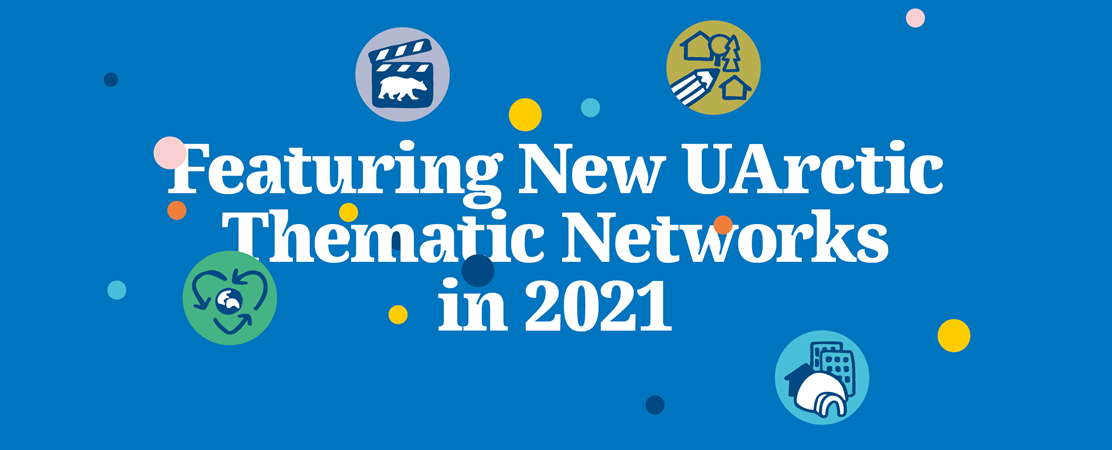Featuring New UArctic Thematic Networks in 2021

In May 2021 the UArctic Assembly welcomed seven new Thematic Networks to UArctic. In this article, the leads of four networks share some of the background on why their networks were established and what difference their collaboration makes.
Why did you decide to put your Thematic Network together?
Circular Economy: We need to enhance the collaboration between universities to accelerate the transition towards circular economy in different regions. Universities are wide impactors in their regions and in collaboration with different stakeholders.
Arctic Indigenous Film: We support Indigenous film makers all over the Arctic. Our Thematic Network is not only about the films - it is also about the magic of storytelling and, above all, the miracle of collaboration. Indigenous peoples need to tell their own stories in their own ways. The stories are creating our futures; that’s why we need to give opportunities to our own people to make films.
Bioregional Planning for Resilient Rural Communities: The founding partners at UNE, UHI and the Agricultural University of Iceland saw an opportunity to create a northern-focused community of practice around bioregioning that would not only support the development of methodologies, but also allow the partners to curate and disseminate strategies that could be shaped to fit the needs of the people and the place.
Arctic Urban Planning and Design: We believe that there needs to be an integrated approach between revolutionary technology advances and evolving cultural character. Therefore we have brought social scientists, architects, engineers, and communities and businesses together on one platform to appreciate each other’s concerns and contribute to sustainable development in the Arctic.
Is your Thematic Network linked to existing collaboration, and what extra value does your network bring to it?
Circular Economy: Since circular economy is integrated into a wide variety of activities, our Thematic Network consists of experts from several disciplines. Some of them participate in other UArctic Thematic Networks too. Our network and its broad perspective to wicked challenges can open collaboration also between different Thematic Networks.
Arctic Indigenous Film: We are linked with many other Thematic Networks: Arctic Sustainable Art and Design, BEBO - For the Future of Reindeer Husbandry, Læra Institute. Together with Indigenous colleges we have organized lectures and workshops for Indigenous producers and screenwriters. There is extra value in this kind of collaboration, such as bringing together the local Indigenous people in remote villages, reindeer herders and film makers in the tundra, and getting their unique stories on film.
Bioregional Planning for Resilient Rural Communities: This was our first time all collaborating together, and we have since grown the network to include others. However, many of us had met at conferences and connected through existing work. We saw the potential to use the Thematic Networks structure to create a hub that would accelerate our ideas and their use in creating and implementing plans for sustainable and resilient communities.
Arctic Urban Planning and Design: We are in the early stages of establishing the network, but we have plans to link with others. Some our members are already involved in other Thematic Networks. In due course, we wish to integrate/collaborate with other Thematic Networks through joint activities where relevant, because combining ideas from different expertise and backgrounds always brings new concepts to solve problems.
Why is your Thematic Network and your collaboration important?
Circular Economy: The transition of societies towards more sustainable circular economies requires thorough transformation of everyday behaviours and practices. Therefore the collaboration of higher education institutions is necessary. We can educate new experts with knowledge of circular economy principles and how to combine this kind of knowledge into countering wicked problems.
Arctic Indigenous Film: When we work together, we are stronger and our voice is heard better. Our Indigenous film makers get support from each other, and they will encourage each other to make bigger and more wide-spread international films which have global impacts in large scale, for example in climate change issues.
Bioregional Planning for Resilient Rural Communities: Only in our first year, we have discovered that bioregioning work and its strategies are at the forefront of transforming systems throughout the North. We think our collaboration has the potential to change the way we approach planning for sustainability and resiliency. That new way of seeing the challenge and opportunity can be transformative and allow northern communities to set aspirational visions for thriving in concert with their environments.
Arctic Urban Planning and Design: We follow a holistic approach in construction technology, using sustainable and green materials, environmentally friendly energy systems, and maintaining the cultural heritage of the High North by involving local communities. In addition to social scientists, architects, and engineers, we also aim to bring in stakeholders from outside the education sector to participate in knowledge sharing events. Understanding local issues is very important for designing education, training materials for the students, companies working in the region. Dialogue and collaboration are also important for initiating local development projects.
Leads of the Thematic Networks
Circular Economy: Sanna Tyni, Petri Muje
Arctic Indigenous Film: Anne Lajla Utsi, Liisa Holmberg
Bioregional Planning for Resilient Rural Communities: Holly Parker, Stuart Gibb
Arctic Urban Planning and Design: Rajnish Kaur Calay
